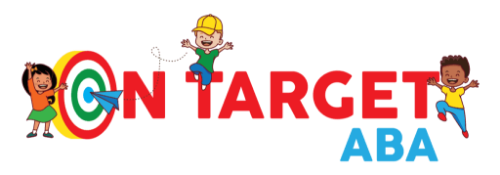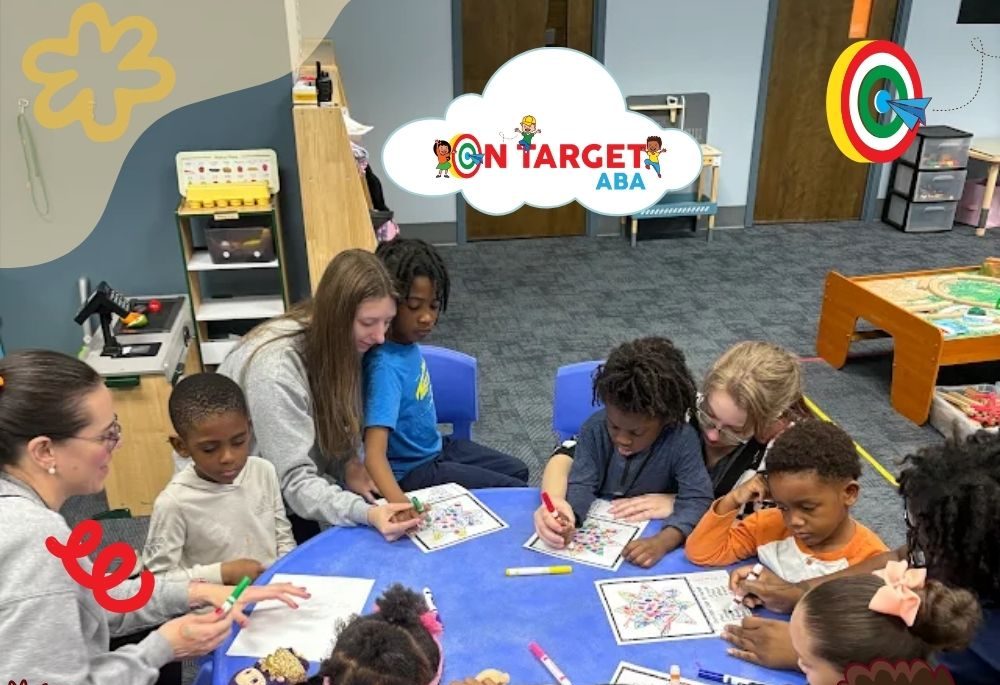🧠 AI Summary:
This blog explores how group coloring activities in ABA therapy strengthen communication, social interaction, emotional regulation, and fine motor skills. Parents will learn why structured group activities — like the one shown in the photo — are powerful tools for growth, connection, and joyful learning at On Target ABA.
A Simple Activity With a Big Impact
At On Target ABA, we believe meaningful growth happens in the everyday moments — the smiles shared across a table, the gentle reminders to take turns, the pride in choosing colors independently.
The group coloring activity in ABA therapy shown in the photo is a beautiful example of how simple, structured activities can support communication, social-emotional development, and joyful learning.
Surrounded by peers and guided by compassionate therapists, the children created artwork while also practicing skills that will last far beyond the page: language, sharing, patience, awareness of others, cooperation, and confidence.
These moments represent the heart of what we do at On Target ABA — meeting each child exactly where they are, celebrating every milestone, and turning learning into something joyful.
Why Group Coloring Activities Matter in ABA Therapy
A group coloring activity in ABA therapy may look like fun (and it absolutely is!) — but it’s also a powerful therapeutic opportunity.
Coloring together helps children:
- Build social skills such as sharing, turn-taking, and group participation
- Strengthen communication through requesting materials and responding to peers
- Practice fine motor skills like grasping markers and controlling movement
- Learn emotional regulation, especially when managing excitement or frustration
- Develop flexibility when plans or colors change
Because the setting is playful and low-pressure, children feel safe to explore, imitate, communicate, and experiment.
According to the CDC, structured play supports the development of social-emotional and communication skills — two essential goals in ABA therapy.
How a Group Coloring Activity in ABA Therapy Is Structured
At On Target ABA, activities like these are carefully planned to maximize learning without overwhelming the children.
Here’s how our team typically structures a group coloring activity in ABA therapy:
1️⃣ Gathering Together
Therapists help children transition to the group table using visual schedules, verbal reminders, or gentle prompts.
2️⃣ Clear Expectations
Therapists briefly explain the activity, demonstrating how to choose colors, share markers, and stay in their seats.
3️⃣ Modeling & Imitation
Children watch their therapist color, choose markers, and label colors — providing opportunities to imitate both actions and words.
4️⃣ Natural Opportunities for Communication
Kids organically practice skills like:
🗣️ “Can I have the red marker?”
🖍️ “I want blue, please.”
🙋 “My turn next.”
Even nonverbal children participate through pointing, gesturing, or using picture icons.
5️⃣ Reinforcement & Celebration
Therapists praise effort, social interaction, and flexibility:
- “Great sharing!”
- “Nice asking!”
- “I love how you waited for your turn!”
Positive reinforcement makes children want to join these activities again and again — and that consistency builds skills.
Building Social Skills Through Group Coloring
One of the biggest benefits of a group coloring activity in ABA therapy is how naturally it supports social skill development.
Children practice:
- Eye contact while requesting materials
- Waiting appropriately while a peer finishes with a color
- Responding to social cues
- Participating in a shared task
- Using manners (“please,” “thank you”)
- Understanding personal space
The group setting mirrors school environments, making these skills essential for classroom readiness.
This aligns with findings from Autism Speaks, which highlight the importance of structured group interaction for children with autism.
Communication Skills Strengthened Through Play
Communication growth happens constantly during these activities—without forcing formal practice.
A child may learn to:
- Request needed materials
- Label colors
- Comment on their drawing
- Respond to peers (“That’s pretty!” “I like your picture!”)
- Follow simple directions (“Color the tree green.”)
These moments feel natural, joyful, and motivating — which is exactly why communication thrives.
Fine Motor Skills in ABA Therapy
A group coloring activity in ABA therapy also strengthens fine motor skills that children need for school and everyday life.
Coloring targets:
- Hand strength
- Pencil grasp
- Writing endurance
- Coordination
- Bilateral hand use
- Pre-writing strokes (lines, curves, circles)
These foundational movements prepare children for handwriting, self-care skills, and other functional tasks.
Emotional Regulation & Flexibility
Group activities teach children how to navigate emotions such as:
- Excitement
- Frustration
- Disappointment
- Pride
For example:
- If a child wants the same color as a peer, therapists guide them through waiting or choosing another option.
- If a child colors outside the lines, they learn that mistakes are okay.
- If a picture doesn’t look how they expected, they practice coping strategies.
These lessons are small in the moment — but in the bigger picture, they support lifelong emotional resilience.
Peer Interaction: Learning From Each Other
Children learn so much by watching their peers — one of the biggest benefits of a group coloring activity in ABA therapy.
Kids observe how others:
- Choose colors
- Hold a marker
- Start and finish their artwork
- Ask questions
- Share materials
Peers become models, partners, and motivators — creating a positive social learning environment.
How On Target ABA Staff Support Success
Our therapists play a key role in creating a supportive learning environment. During activities like the one shown in your photo, they are:
✨ Modeling
✨ Redirecting
✨ Offering gentle prompts
✨ Reinforcing positive behavior
✨ Encouraging independence
✨ Celebrating every victory
They make sure each child feels included, supported, and proud of their work.
A Closer Look at the Activity From the Photo
The photo from the On Target ABA clinic captures this beautifully:
🖍️ Multiple children seated together
💙 Therapists supporting them
🌈 Kids fully engaged with their coloring pages
✨ A warm, calm, structured environment
🧩 Smiles, focus, and teamwork
This moment reflects everything we believe in at On Target ABA — connection, joy, meaningful skill-building, and a supportive community.
Bringing Group Coloring Into Your Home
Parents can easily incorporate similar activities at home to reinforce skills:
💙 Set up a mini coloring station
💙 Invite siblings to join
💙 Practice sharing crayons
💙 Narrate colors and actions
💙 Celebrate creativity
💙 Keep it low-pressure and fun
Even five minutes of group coloring can build connection and communication.
Ready to See Group Learning in Action?
Our centers in
…all offer structured group activities like this one — helping children build meaningful connections while developing essential life skills.

